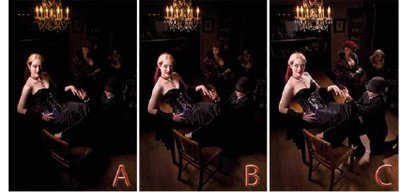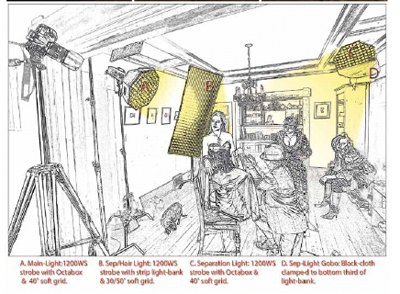articles/Lighting/bordello-page2
Bordello Bride - part 2 of 1 2 3
by Dave Montizambert Published 01/12/2013

The final bit of lighting kit was a white fabric reflector panel, placed to the right side of the camera in front of the set-up - not shown in the diagram for obvious reasons (it would block our view of the set-up). Its purpose was to act as a 'specular fill' on the shiny laser-cut stainless steel corset graciously lent to me for the shoot by its creator, artist Stefan Rogenmoser.
Before the addition of the white panel, the corset appeared black; it was reflecting the dark unlit surfaces of the living-room behind the camera.
Once the panel was in place, the corset now reflected the white fabric of the panel over its mirror-like surface - the white fabric was illuminated by light from the light-banks spilling past the subjects. Placing it was a matter of directing first assistant Monty Noyes as he moved it back and forth while I viewed the placement change through the camera. Once we found the right spot (in technical speak 'when the angle of incidence equals the angle of reflection'), the corset came alive with the panel's reflection. Placing specular highlights or reflections must be viewed from camera angle - if you view the placement of specular highlights over your subject's surface from any other position other than the camera's, the resulting image will show these specular highlights in a different spot - specular highlights are angle sensitive, shadows are not. The reflector also added a little fill to the scene's shadows about four stops below the camera setting.
To create great location lighting, it is all about controlling the existing ambient light. Lighting with strobes or flash really makes this a lot easier since these electronic sources free up the shutter speed for controlling the ambient light.
When shooting indoors on location, more often than not, the walls and ceiling will be white or light in tone; this is great if you need low shadow contrast (shadows that are less dark). But if you want to create images with more drama, with high shadow contrast (darker shadows), then these lighttoned surfaces work against you. My three most favoured controls for this are:
1. Use soft-grids on light-banks and honeycomb grids or barn-doors on direct lights. With soft-grids and honeycomb grids, their array of cells narrow the spill of light allowing less light to spill past subject(s) to the walls and ceiling. The further you move a light out of the scene, the greater the spread of light over that area, but fear not, there is a range of grids available, usually from 60˚ to 20˚ to narrow that wide spread of light.

2. Work with your lights in close to the subject(s). When you move your light further away from the subject, the amount of light striking your subject relative to the light striking the distant walls and ceiling starts to even out. Once you adjust exposure for the loss of light on your subject, a proportionally greater amount of light bounces off these surfaces and back into your subject's shadows making the shadows brighter. Conversely, as you move your light closer to the subject, the light striking your subject increases in brightness at a faster rate than the light striking the walls and ceiling - this is assuming that the walls and ceiling are further from the light than is the subject. Since these surfaces receive proportionally less light, they reflect less light back into the shadows, creating darker shadows. For a photographer who likes high shadow contrast, a large studio (wall and ceiling further away) with dark-toned walls is the bomb. Working with the lights in close was not an option on Indecent Proposal because the lights needed to be further away to be out of camera frame.
3. Use gobos, block the light reflecting off or onto these surfaces with dark-toned things like black fabrics and black panels.
And what's with the cat in the left corner of the frame? Why that's Mr Lucky, it's a cat-house after all.
Please Note:
There is more than one page for this Article.
You are currently on page 2 Contact Dave Montizambert
1st Published 01/12/2013
last update 09/12/2022 14:51:51
More Lighting Articles
There are 0 days to get ready for The Society of Photographers Convention and Trade Show at The Novotel London West, Hammersmith ...
which starts on Wednesday 15th January 2025





